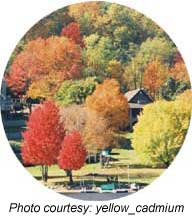
Dimdima
Online Children's Magazine from India

Dimdima
Online Children's Magazine from India

I have just returned from a camping trip and I can't wait to tell you all about the spectacular show I have witnessed. Every year in the United States, as summer gives way to autumn, thousands of tourists head to the North Eastern states like New England, to witness the glorious natural phenomenon called "Fall Colours."
Autumn is popularly known as "Fall," in the United States, because many trees lose their leaves in this season. This is how the trees prepare to withstand the rigors of the cold winter months. Just before the trees shed their leaves, however, they turn colour. The deep, dark green of the summer months gives way to glorious red, brown, yellow, orange and rust, thereby painting the autumn landscape with golden hues.
Ancient Indian tribes like the Cherokees had many interesting stories to explain the reason behind this curious natural ritual. They believed that at the beginning of creation, when all the plants and trees got life, they were asked to stay awake for seven nights in order to attain special powers. As the days passed, most plants gave in to exhaustion. Only a few trees like the pine, the holly and the spruce were able to keep awake. These trees were granted a boon and therefore, they stay green throughout the year. The other trees that fell asleep are forced to shed their leaves in autumn.
But today, we know that the leaves change colour and fall down due to a chemical reaction called "Photoperiodism". During the hot summer months, the leaves absorb heat from the sun's rays and make food that helps the trees to grow. This process is called "Photosynthesis". Leaves can do this because of a pigment called chlorophyll. The presence of chlorophyll makes the leaves green.
During fall, the sun's rays begin to weaken in intensity. There is not enough light for the leaves to synthesize. The trees, therefore, shut down their "food making factories," and live off the food that they have stored in summer. Chlorophyll disappears, and the leaves lose their green colour. The leaves of certain species, including the birch and hickory, contain another pigment called carotene. These leaves turn yellow in color. Other trees like maples and oaks contain a pigment called anthocyanin. This pigment is responsible for red or purple leaves. Many of these colours are present in summer as well, but the dominant green colour produced by chlorophyll covers them up.
The intensity of colour variations is dependent upon weather conditions. The brightest hues are noticeable when warm sunny days are followed by cool dry nights. The most beautiful fall colours are apparent in New England where the maples and birches all turn colour at around the same time, much to the delight of the large tourist crowds.
Dimdima is the Sanskrit word for ‘drumbeat’. In olden days, victory in battle was heralded by the beat of drums or any important news to be conveyed to the people used to be accompanied with drumbeats.
Bharatiya Vidya Bhavan
K. M Munshi Marg,
Chowpatty, Mumbai - 400 007
email : editor@dimdima.com
Bharatiya Vidya Bhavan
505, Sane Guruji Marg,
Tardeo, Mumbai - 400 034
email : promo@dimdima.com
Dimdima.com, the Children's Website of Bharatiya Vidya Bhavan launched in 2000 and came out with a Printed version of Dimdima Magazine in 2004. At present the Printed Version have more than 35,000 subscribers from India and Abroad.